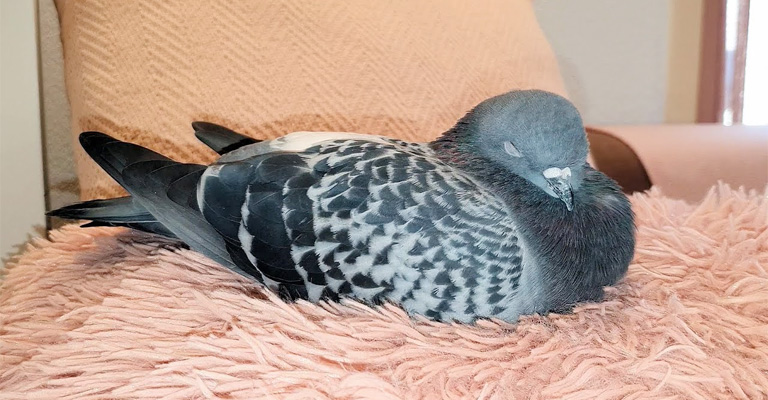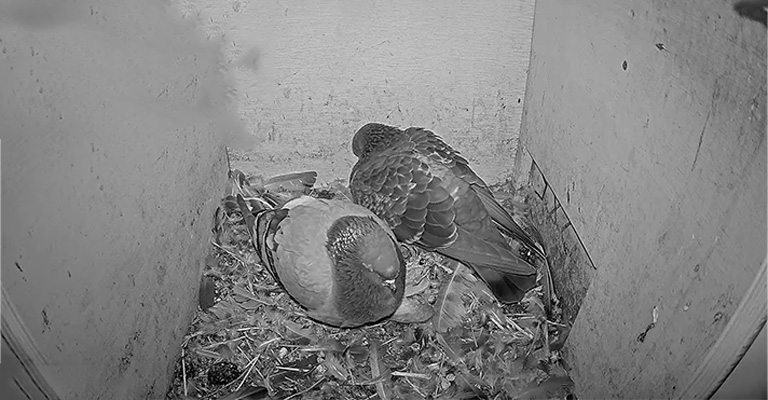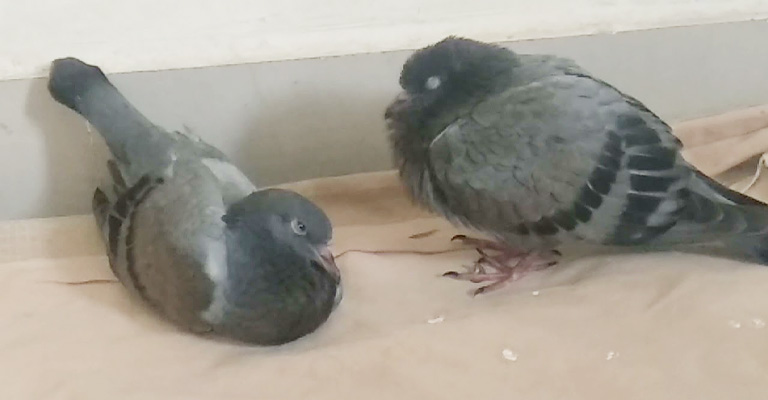Nestled within our bustling urban landscapes, pigeons often stand as both a familiar sight and an enigma. Amidst the city’s concrete canyons, these birds defy expectations by opting to roost on narrow ledges, windowsills, and wires rather than seeking refuge within traditional nests.
This curious behavior sparks intrigue, leading us to ponder the reasons behind their nocturnal preference.
Unlike their avian counterparts, such as sparrows and swallows, who diligently return to their cozy nests each night, pigeons appear to spurn these architectural marvels.
In the following exploration, we delve into why do pigeons not sleep in nests. From the adaptability of urban living to the influence of ancestral habits, this investigation uncovers the fascinating world of pigeon roosting.
We will provide you with insight into the adaptability and resilience of these often-overlooked city dwellers.

Why Do Pigeons Not Sleep in Nests?
Let’s delve into the intriguing world of pigeon roosting habits and explore the factors that contribute to their preference for unconventional sleeping arrangements.
Evolutionary Adaptations
Pigeons’ decision to avoid nests might have roots in their evolutionary history. Over millions of years, pigeons’ ancestors, which lived in cliffside crevices and tree hollows, developed the ability to roost in less conventional spots.
This adaptation allowed them to better evade predators and utilize open spaces for nighttime rest.
Urban Resilience
Pigeons have become masters of urban living. As cities expanded, so did their potential habitats. Pigeons capitalized on the myriad of ledges and architectural features provided by buildings.
The absence of natural predators in urban environments means that pigeons can confidently perch in the open without the same risks they would face in the wild.
Energy Efficiency

The act of building and maintaining nests requires significant energy expenditure. By avoiding nest construction, pigeons conserve energy that they can allocate towards foraging and other essential activities. This strategy allows them to adapt to the constant search for food sources in urban areas.
Social Dynamics
Pigeons are highly social creatures, often found in large groups. Sleeping near one another on exposed perches might enhance their social bonds and provide a level of protection through collective awareness. Nests, in this context, might be reserved for breeding and raising young.
Temperature Regulation
Pigeons possess a high tolerance for temperature variations, and roosting on elevated spots can help them regulate their body temperatures.
Air circulation around exposed perches may prevent overheating during warmer nights and provide better insulation during colder nights.
Avoiding Parasites
Nests can become breeding grounds for parasites and pathogens. Pigeons might have learned to avoid the buildup of these harmful agents by sleeping in open areas, reducing the risks of infestations and infections.
Nest Competition
In urban environments, space for nesting can be limited, and there might be intense competition among pigeons for suitable nesting sites.
By not sleeping in nests, pigeons might be avoiding territorial conflicts and ensuring they have access to roosting spots without engaging in confrontations.
Nocturnal Predation Avoidance
While pigeons might not have many daytime predators in urban areas, nighttime can bring a different set of threats.
By roosting on exposed perches, pigeons can potentially avoid surprise attacks from nocturnal predators that might target them while they are asleep in the safety of a nest.
Enhanced Awareness
Perching on exposed locations offers pigeons a better vantage point. This elevated position allows them to detect potential threats more easily and react quickly if danger approaches. This heightened awareness could be crucial for their survival in both urban and natural settings.
Seasonal Factors
Pigeons’ roosting habits might also change seasonally. During colder months, when maintaining body heat is essential, they might prefer more sheltered spots. However, in warmer months, they could seek out open, breezy perches to stay cool.
Where Do Pigeons Sleep at Night?

Pigeons are known for their adaptability and resourcefulness when it comes to choosing sleeping spots.
At night, they often seek out secure and sheltered locations that offer protection from predators, the elements, and disturbances. Here are some common places where pigeons tend to sleep at night:
Building Ledges and Windowsills
Pigeons are notorious for perching on building ledges and windowsills, especially in urban environments. These spots provide them with a slightly elevated position, protection from ground-based predators, and a certain level of shelter from rain and wind.
Bridges and Overpasses
Pigeons are often seen roosting on the beams and supports of bridges and overpasses. These structures provide a sense of security and are usually away from human disturbances during nighttime.
Trees and Shrubs
Although less common in urban areas, pigeons might choose to sleep in trees and shrubs, especially if there’s dense foliage that provides cover and protection.
Utility Wires and Streetlights
Pigeons are skilled at balancing on narrow surfaces, making utility wires and streetlights attractive sleeping spots. These perches allow them to stay off the ground and avoid potential ground-based threats.
Rooftops
Flat rooftops of buildings offer pigeons a relatively safe and spacious area for resting. The height of rooftops can provide a sense of security, and they might gather in groups on these expansive surfaces.
Under Eaves and Eavesdroppers
Pigeons might find shelter under eaves and overhangs, which shield them from rain and wind. These spots offer a certain level of privacy while also allowing them to stay relatively hidden.
Abandoned Structures
Pigeons are known to seek refuge in abandoned buildings, factories, or other structures. These locations can protect both natural predators and human disturbances.
Cliffs and Rocky Outcrops (In Natural Settings)
In less urbanized areas, pigeons might still exhibit ancestral behavior by roosting on cliffs and rocky outcrops, similar to their wild counterparts.
Note that the specific sleeping spots pigeons choose can vary based on local environmental conditions, the availability of suitable sites, and the presence of potential threats.
Their ability to adapt and make use of a variety of roosting spots contributes to their success in diverse landscapes.
How Do Pigeons Sleep?

Pigeons exhibit unique sleeping behaviors that help them adapt to their surroundings and ensure their safety during rest. Here’s how pigeons sleep:
One-Hemisphere Sleep
Pigeons are capable of sleeping with one hemisphere of their brain at a time. This means that while one half of the brain is in a deeper sleep mode, the other half remains awake and alert.
This adaptation allows pigeons to maintain awareness of their surroundings and react to potential threats even while asleep.
Group Roosting
Pigeons often sleep in groups, especially in urban environments. Sleeping in a group provides safety in numbers – pigeons can alert each other to any dangers and take collective action if needed.
Balanced Perching
Pigeons have a unique ability to perch on narrow surfaces without falling. This helps them find suitable roosting spots on building ledges, utility wires, and other precarious perches.
By tucking their heads under their wings and balancing on one leg, they conserve body heat during sleep.
Nocturnal Activity
Pigeons are more active during the day, and they tend to be most active during the early morning and late afternoon.
As a result, they often engage in feeding, socializing, and other activities during these times. Their sleep periods are usually longer during the night when there’s less activity.
Secure Locations
Pigeons choose sleeping spots that provide protection from predators and the elements. They often seek out sheltered areas like building ledges, windowsills, or even dense vegetation. This ensures they have a safe place to rest without the risk of predation.
Head Tucked Under Wing
When pigeons sleep, they typically tuck their heads under their wings. This posture helps them conserve body heat and protect their heads and necks while resting.
Adaptability
Pigeons are highly adaptable birds, and their sleep patterns can change based on their environment.
In urban areas, they might adjust their sleep behaviors to coincide with human activity, while in more natural settings, their sleep patterns could be influenced by factors like the presence of predators and the availability of food sources.
Overall, pigeons’ sleep behaviors are a fascinating combination of evolutionary adaptations and practical strategies that allow them to thrive in various habitats, including the ever-changing landscapes of cities.
FAQs
Pigeons coo as a way to communicate with each other. The cooing sounds serve various purposes, including attracting mates, establishing territory, and maintaining social bonds within their flocks.
Different cooing patterns convey different messages, helping pigeons navigate their complex social interactions.
In the wild, pigeons typically have a lifespan of 3 to 5 years. However, pigeons that live in urban environments may have shorter lifespans due to increased exposure to pollution, predators, and other urban hazards. Pigeons in captivity can live longer, sometimes reaching 15 years or more.
Most pigeon species are sedentary, meaning they do not undertake long migrations like some other bird species. Instead, they tend to remain in the vicinity of their preferred habitats throughout the year.
Pigeons can be considered pests in urban areas due to their potential to cause damage to buildings, vehicles, and infrastructure.
Their droppings can be corrosive and unsightly, and their presence in large numbers can lead to sanitation issues.
Yes, pigeons are known for their remarkable ability to find their way home from long distances.
This skill, known as homing instinct or homing behavior, has been used for centuries in pigeon racing and messaging.
Parting Words
The decision of pigeons to eschew nests in favor of unconventional roosting spots is a testament to their remarkable ability to adapt and thrive in diverse environments.
As urbanization continues to shape our cities, pigeons have not only found a way to coexist with humans but have also managed to capitalize on the unique opportunities provided by our ever-changing landscapes.
Their preference for exposed perches during sleep hours might be attributed to a blend of ancestral behaviors, safety considerations, and resource availability.
By studying these seemingly small yet significant behaviors, we gain a deeper appreciation for the intricate interplay between wildlife and the urban world we’ve constructed.
So, the next time you catch sight of a pigeon settled on a wire or a windowsill, remember that beneath those seemingly simple actions lies a complex story of adaptation that echoes the fascinating coevolution of nature and human civilization.